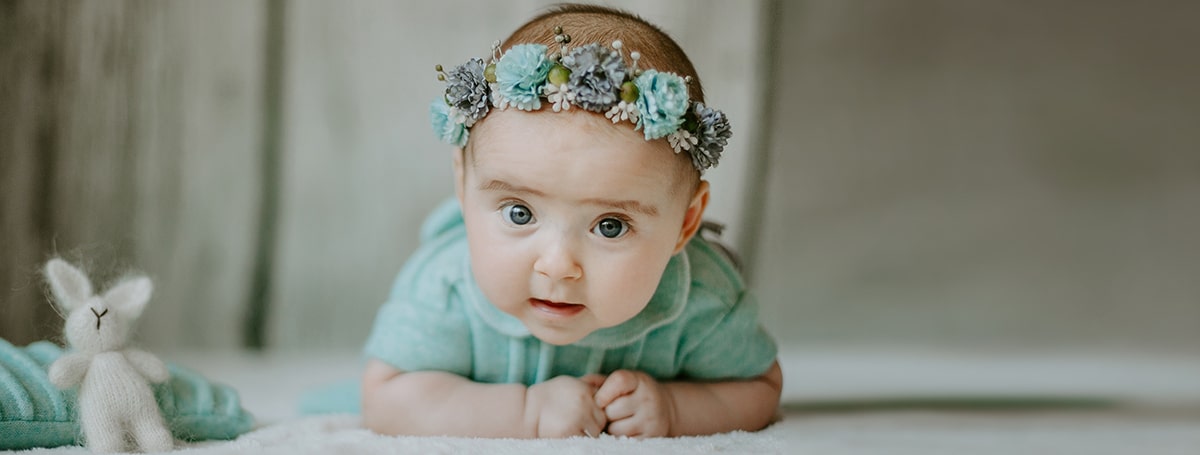4-Month-Old Baby Milestones: Growth, Development, and Key Changes
Wow, has it really been four months already? If you’re marveling at how fast your little one is growing, you’re not alone! At four months, your baby is hitting exciting new milestones—big gummy smiles, adorable coos, and even the first signs of rolling over. Developmental milestones are tracked at different ages, helping you understand what to expect as your baby’s growth continues. This phase is full of discoveries, both for your baby and for you as a parent. These milestones are how your baby learns about their environment, exploring new skills and sensations every day. Babies learn through play, interaction, and exploration, making each milestone an important part of how your baby learns about the world. From physical growth to cognitive leaps, let’s explore what 4 month milestones to expect and how you can support your baby’s development with love and encouragement.
4 Month Baby Milestones: Growth
At four months, your baby’s growing at a remarkable pace, and you might notice your baby’s chubby cheeks and adorable rolls getting even cuter. By this stage, most babies have doubled their birth weight, thanks to all those late-night feedings and steady nourishment. Breast milk or formula is still the primary source of nutrition and plays a crucial role in supporting your baby’s growth at this stage. If your little one was born at around 3.20 kg, they likely weigh close to 6.35 kg now—a sign of healthy development. While every baby’s growth is unique, here’s a general idea of what you can expect at this stage:
- Average weight of 4-month old baby girls: 6.40 kg
- Average length of 4-month old baby girls: 24.50 inches
- Average weight of 4-month old baby boys: 7 kg
- Average length of 4-month old baby boys: 25.25 inches
At different ages, babies reach important developmental milestones that help track their progress and highlight how your baby’s abilities and skills are developing.
It’s important to remember that these numbers are just averages. Some babies may weigh a bit more or less, and that’s completely normal. For example, one baby might start rolling over at four months, while another may take a few more weeks—both are within the range of typical development. Baby development at 4 months varies from child to child, and what matters most is steady growth over time. During each paediatric checkup, your baby’s doctor will track their measurements on a growth chart, ensuring they’re on the right path. Monitoring your baby’s development helps ensure healthy growth and allows for early intervention if needed. So, whether your little one is on the higher or lower end of the scale, rest assured that as long as they’re happy, active, and thriving, they’re growing just fine.
Our Products
4 Month Old Baby Milestones: Movement and Physical Development
At 4 months old, babies begin developing better hand-eye coordination, muscle strength, and control over their movements. As babies start moving more, it’s important to create a baby safe environment to support their exploration and minimize risks. This newfound mobility sets the stage for exciting milestones in the coming months. Over the next few months, you can expect your baby to reach new physical milestones, such as improved head control, practicing lifting their head in a sitting position, and attempting to sit up.
When your baby tries to sit up, you can gently pull them to a seated position to help build core strength. Practicing sitting with support helps babies develop the muscles needed for independent sitting. Improved head control and the ability to maintain a sitting position are important indicators of your baby’s physical development.
Grasping, Reaching, and Exploring
One of the most noticeable 4 month old milestones is your baby’s ability to reach for objects and grasp them with their fingers and thumb. If it’s within their reach—whether it’s a toy, a rattle, or even your hair—they’ll try to grab it. At this stage, everything they hold will likely go straight into their mouth. This behaviour is not just about curiosity; it helps babies develop oral skills essential for eating solid food in the future. Just be cautious of small objects that could pose a choking hazard.
Head Control and Upper Body Strength
By now, your baby should be able to hold their head up steadily without support. This is one of the key 4 month milestones when it comes to their physical development, as strong head control is a foundation for sitting up and, eventually, walking. During tummy time, they may start pushing up onto their elbows or even their hands in a “mini push-up” position, strengthening their chest and back muscles.
Rolling Over and Sitting with Support
Many babies at this age start rolling over from their stomach to their back—or at least attempt to. If your baby has had limited tummy time, they might take a little longer to reach this milestone, but they’ll get there. This is also the time when babies may begin sitting up with support, holding their balance for short periods when propped up with pillows or sitting in your lap.
Leg Strength and Standing Practice
If you gently hold your baby in a standing position, you might notice them pushing down with their legs. This instinctive movement helps build leg strength, preparing them for future milestones like standing and walking. Some babies even start playing with their toes, bringing them to their mouths like built-in toys.
Our Products
4 Month Baby Milestones: Cognitive Development and Sensory Awareness
At 4 months old, your baby’s brain is growing rapidly, and they are becoming more aware of their surroundings. The stage of baby development at 4 months is all about exploring the world and learning through interactions. Around this age, your baby’s hearing is developing, allowing them to recognize familiar voices and respond to different sounds. Talking to your baby is important to encourage early language development. Engaging your baby by talking, singing, and making funny sounds can stimulate their interest and help them learn new words. At this stage, tracking your baby’s development is important to ensure they are reaching key milestones–such as their ability to imitate words and sounds–and to recognize any early signs of delays.
Improved Vision and Recognition
Your baby’s eyesight is now much sharper, allowing them to recognise familiar people and objects from a distance. As your baby’s eyesight develops, they are better able to connect what they see with other senses such as hearing, taste, and touch, supporting their overall cognitive development. They will follow moving objects with their eyes, track them from side to side, and show interest in bright colours, patterns, and shapes.
Hand-Eye Coordination and Object Interaction
One of the key 4 month old baby milestones is the development of hand-eye coordination. Your baby will reach for toys with one hand, grasp them, and explore different textures. Playing with toys isn’t just fun—it helps build essential cognitive and motor skills. Since their curiosity is growing, they will look at their hands with fascination, understanding that they can control their movements.
Memory
At this age, babies begin to show early signs of memory. They will recognise familiar voices, including that of their parents. If bottle-fed, they might even open their mouth in anticipation when they see the bottle.
4 Month Old Milestones: Social and Emotional Growth
At this stage of 4 month milestones, your baby is becoming more expressive, interactive, and responsive to social cues. Using different facial expressions when interacting with your baby helps them learn to communicate and understand emotions. Your baby is developing the ability to laugh, and this laughter helps foster bonding and strengthens your connection. Some key social and emotional growth milestones for both babies and children include:
Strengthening Social Bonds
Your baby now enjoys making eye contact, smiling, and engaging in playful interactions with familiar faces. They may smile spontaneously to capture your attention and show excitement when they see you. Playtime becomes a fun and essential part of their social development, and they may fuss or get frustrated when play stops, indicating their growing understanding of enjoyable activities.
Expressing a Range of Emotions
By this stage, babies can express happiness, excitement, and even mild frustration through facial expressions, coos, and body movements. They may chuckle when amused and show delight during interactive play. Instead of crying immediately, they might start whining or fussing to communicate their needs, making it easier for parents to distinguish between hunger, discomfort, or tiredness.
Developing Early Language Skills
One of the key 4 month baby milestones is the development of early language skills. Your baby may babble and coo, making sounds like “ah-goo” and “oooo,” often in response to your voice. Some babies may even attempt to mimic sounds they hear frequently, like “ma-ma” or “da-da,” though they might not yet associate them with parents. Imitating your tone and copying facial expressions is another way your baby is learning to communicate.
Building Awareness and Interaction
Your baby’s interest in their surroundings is growing, and they enjoy looking at their reflection in the mirror, often smiling and babbling at themselves. Their cries also become more distinct, helping parents understand whether they are hungry, tired, or in discomfort.
Our Products
4 Month Milestones: Feeding Habits and Nutritional Needs
As your baby reaches 4 month milestones, you may notice a shift in their feeding patterns and nutritional needs. At this stage, their stomach capacity has increased, allowing them to consume more at each feeding while going longer between meals. The rapid growth of the newborn phase has started to slow down, which means they may not need to eat as frequently as before. Proper nutrition during this period is essential to support your baby’s growth and ensure they meet important developmental milestones.
Feeding Frequency and Quantity
By 4 months old, both breastfed and bottle-fed babies typically feed every 4 to 5 hours. If your baby is bottle-fed, they may consume 110 to 170 grams of formula or breast milk per feeding. Nighttime feedings may still occur, but if your baby sleeps through the night without waking up for food, that’s completely normal. There is no need to wake your baby for feedings unless advised by a pediatrician.
Understanding Hunger Cues
Although babies at this age naturally transition to fewer but larger feedings, it’s still essential to follow their hunger cues. Breastfed babies, in particular, may nurse not just for nutrition but also for comfort, soothing, or during growth spurts. Paying attention to your baby’s signals ensures they receive the nourishment they need while maintaining a healthy feeding routine.
Introduction to Solid Foods
Many parents wonder when to start solid foods, and while some babies may show readiness between 4 and 6 months, it is generally recommended to wait closer to 6 months, especially for exclusively breastfed infants. Signs that indicate a baby may be ready for solids include:
- Having strong head control
- Sitting upright in a high chair or infant feeding seat
- Opening the mouth eagerly when offered food
- Moving food to the back of the mouth and swallowing instead of pushing it out with the tongue
If you are unsure about when to start solids, it’s best to consult your child’s healthcare provider. Even after introducing solids, breast milk or formula will remain the primary source of nutrition until your baby turns one year old.
4 Month Baby Milestones: Sleeping Patterns
One of the most significant 4 month baby milestones is the shift in sleep patterns. The good news? Many babies at this age start sleeping for longer stretches at night, sometimes even six to eight hours straight. However, the not-so-good news is that some infants experience a 4-month sleep regression, where their sleep temporarily becomes more disrupted. Sleep regressions typically occur during major developmental phases, and while not all babies go through them, many parents notice sleep disturbances around 4 months, 6 months, 8 months, and 1 year. If you are concerned about your baby’s sleep or development, it is always a good idea to speak to your healthcare provider for reassurance and guidance.
How Much Sleep Does a 4-Month-Old Need?
The amount of sleep a 4-month-old baby requires can vary, but most experts suggest a total of 12 to 16 hours per day, which includes both nighttime sleep and naps. Some babies may sleep around 10 hours at night with 4 hours of daytime naps, while others may have different sleep distributions. If your baby is naturally a good sleeper, consider yourself lucky! If not, don’t worry—there are ways to help establish a healthy sleep routine.
One way to ensure uninterrupted sleep is by keeping your baby dry and comfortable throughout the night. Teddyy Baby Diapers provide overnight protection, allowing your baby to sleep peacefully without discomfort. With soft elastic, breathable material, and a design ideal for sensitive skin, these diapers help prevent irritation and keep your baby cosy all night long.
Nap Schedule and Sleep Training
At this stage, babies generally take two to three naps per day, each lasting about one to two hours. Some may nap once in the morning and once in the afternoon, while others may need a shorter evening nap before bedtime. Babies can usually stay awake for 2 to 4 hours between naps, but every infant is unique, so paying attention to their sleep cues is essential.
This is also the time when some parents consider sleep training. While not a necessity, sleep training can help babies develop better sleep habits, especially if nighttime wake-ups have become exhausting. There are various sleep training methods available, so parents can choose an approach that aligns with their comfort level and parenting style.
Dealing with Sleep Regression
If your baby starts waking up more frequently at night, don’t panic—it’s a natural part of their development. A 4-month sleep regression can be frustrating, but it’s temporary. Sticking to a consistent bedtime routine, following a regular nap schedule, and being patient can help your baby adjust.
Conclusion
As you celebrate your baby’s 4 month milestones, take a moment to appreciate just how far they’ve come in such a short time. From those first adorable giggles to their growing curiosity about the world, every new skill they develop is a testament to their rapid growth. This phase is full of excitement, but it also comes with its share of challenges—sleepless nights, feeding adjustments, and endless diaper changes. Remember, every baby develops at their own pace, and what matters most is that they’re happy, healthy, and surrounded by love. Enjoy these precious moments, because before you know it, your little one will be onto the next big milestone.
Faq's
1. What are the key milestones for a 4-month-old baby?
By 4 months, babies can hold their head steady, roll from tummy to back, smile spontaneously, coo more frequently, and show stronger interest in faces and toys.
2. How much should a 4-month-old baby grow in weight and height?
Most babies gain around 1–1.5 lbs and grow about 0.5–1 inch in this month. Growth patterns may vary depending on feeding, genetics, and health.
3. How much should a 4-month-old sleep and feed?
Babies at this age sleep about 12–16 hours in 24 hours, often with longer stretches at night, and feed every 3–4 hours. Some may begin to show more predictable routines.
4. Can my 4-month-old recognize me and respond to my voice?
Yes. At 4 months, babies can clearly recognize familiar faces and voices, often smiling or babbling in response to interaction.
5. What activities help my 4-month-old’s development?
Tummy time, gentle play with rattles, showing colorful books, singing, and interactive face-to-face time help strengthen muscles, vision, and communication skills.
6. When should I consult a doctor about my 4-month-old’s development?
Contact your pediatrician if your baby is not making eye contact, has trouble holding their head steady, isn’t babbling, or seems uninterested in interaction.





